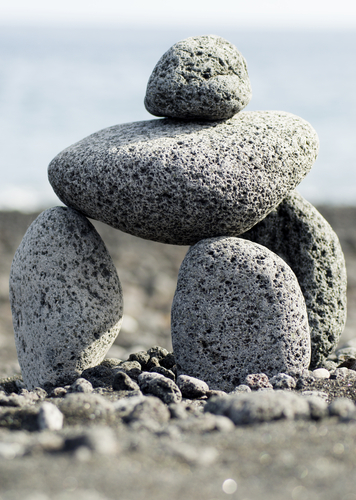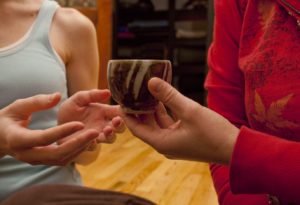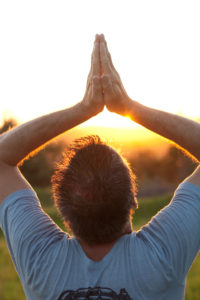Omaha Yoga Path Post
Standing Poses

Here is a sheet displaying most of the common standing poses practiced in yoga. Working standing poses is one of the best ways to build and enhance your practice. When you can be stable and strong in these positions all other poses will be accessible to you.
Benefits to Mindfulness
Benefits of Mindfulness Practice & Meditation
by Shinzen Young

Increased Appreciation of Life
A person with high base-line attentiveness finds, in general, all life activities to be more fulfilling. Intrinsically pleasant experiences (food, music, sexuality, etc.) are vastly more intense and satisfying simply because one is more fully “in the moment.” Furthermore, ordinary, banal experiences (washing dishes, driving to work, social conversation, etc.) take on a quality of extraordinary vibrancy and fascination. Boredom becomes a thing of the past.
Reduced Suffering
Physical Pain
Dealing with pain from illness or injury becomes a major issue for most people sometime in their lives. Indeed for millions of chronic pain victims, it is the issue of every moment of their lives. When analgesics and medical treatment cannot mitigate the pain, what option is left? Must one be subject to meaningless, abject suffering? Absolutely not. It has been clinically demonstrated that in states of sufficiently high concentration, pain, even very acute pain, can be dissolved into a kind of moving energy. This greatly diminishes ones suffering in the moment.
More importantly, when one learns to experience pain in this way, one actually gets a sense of being empowered and even nurtured by it. Thus, meditation skills provide not merely a mode of pain management, but allow one to experience pain as deeply meaningful in the sense of contributing to personal growth and empowerment.
Emotional Pain, Compulsions and Addictions
What is true for physical pain is also true for emotional pain such as fear, grief, anger, jealousy, shame, etc.
Using mindfulness skills, one can clearly detect and discriminate the mental images, internal words and body sensations that constitute the negative emotion as they arise moment by moment. By “deconstructing” the emotion in this way, one becomes less caught up while at the same time allowing the emotion to flow without suppression.
The same skills can be applied to overcoming negative habits and compulsive behaviors such as alcohol, tobacco and drug abuse, eating disorders and so forth, “staying with” the unwholesome urge until it weakens and passes.
Furthermore, the mindfulness itself produces a kind of “intrinsic high” which can replace the unhealthy high of substance and alcohol addiction.
Elevated Performance Levels
Any task is performed more effectively (and joyously!) if one is mindful and focused. These include:
1. More efficient studying for students
2. Increased ability in intellectual pursuits and problem solving
3. Acquisition of skills (languages, performing arts, fine arts, martial arts, etc.)
4. Sports – In sports, heightened attentiveness affects performance in two ways. First, the better you focus, the better your game. Some athletes occasionally spontaneously enter into unusually focused states. The locker room term for this is “being in the zone.” With systematic training in focusing skills, athletes can learn to consistently perform “in the zone.”
Second, focus and equanimity affects sports in the area of endurance. As explained above in the Physical Pain section, high focus imparts the ability to experience pain with reduced suffering. The ability to “break up” the subjective discomfort of fatigue leads to an increase in objective energy which could potentially give a winning edge. Acquiring such an edge through mental concentration represents an attractive alternative for the temptation to gain that edge through drugs.
5. Work – Japanese corporations have long recognized that focused workers are not only more effective, but are happier and more fulfilled because there is an intrinsic pleasure associated with any task done in a highly focused state, even seemingly boring and repetitive tasks. To this end, it is not unusual for big companies to send an entire section of workers to a Zen temple for a week of monastic training.
Effects on Health
1. States of high attentiveness and deep relaxation involve not only the mind but also affect the body and therefore impact one’s health. Brain alpha waves increase, skin conductivity decreases and the metabolism becomes more efficient.
2. Mindfulness helps people be more in contact with and hence more responsive to their bodies.
3. Heightened attentiveness also greatly increases the “high” associated with running and other forms of health-promoting exercises, thus making exercise easier and more appealing.
Improved Interpersonal Relationships At Work And Home
Mindfulness skills impact this arena in two ways. First, they allow one to be more “present” with people, more engaged and less drawn into fantasy and projection moment by moment. Second, they provide a tool to reduce the effects of negative emotions which often get in the way of successful interpersonal communication.
Catalyzing Inner Growth
Most people participate in some form of inner growth process. These include introspection, psychotherapy, body work, self-improvement and motivational seminars, yoga, tai chi, 12-step programs, prayer life, etc. In general all such personal growth processes are vastly more effective when done in a state of heightened mindfulness and equanimity. Attention skill is to personal growth as a catalyst is to a chemical reaction; it dramatically speeds up the rate of the process.
More on Blue

Entitled: Blue dot on pillowcase
The recent assignment to notice the color blue wherever you see it, has been very interesting at the Yoga Path. It went well for the first week when many put a blue dot on their hand and wrist to be reminded to watch for it. We did this with permanent mark from a blue sharpie. I myself refreshed it daily with each class. Unfortunately the permanent marker was not so permanent, so it would soon wash off in a few days with frequent hand-washing. The blue could also transfer to you pillowcase and bed sheets, where it proved to be much more permanent than on human skin.
Nevertheless, the task of noticing blue yielded a few insights and some appreciation for this remarkable ability to see and distinguish the subtleties of color. But blue has mystery all it’s own. As the last Radiolab story revealed, blue is the last color the human consciousness notices. But Rebecca Solnit in A Field Guide to Getting Lost, examines our relationship to this color in life:
“The world is blue at its edges and in its depths. This blue is the light that got lost. Light at the blue end of the spectrum does not travel the whole distance from the sun to us. It disperses among the molecules of the air, it scatters in water. Water is colorless, shallow water appears to be the color of whatever lies underneath it, but deep water is full of this scattered light, the purer the water the deeper the blue. The sky is blue for the same reason, but the blue at the horizon, the blue of land that seems to be dissolving into the sky, is a deeper, dreamier, melancholy blue, the blue at the farthest reaches of the places where you see for miles, the blue of distance. This light that does not touch us, does not travel the whole distance, the light that gets lost, gives us the beauty of the world, so much of which is in the color blue.
 For many years, I have been moved by the blue at the far edge of what can be seen, that color of horizons, of remote mountain ranges, of anything far away. The color of that distance is the color of an emotion, the color of solitude and of desire, the color of there seen from here, the color of where you are not. And the color of where you can never go. For the blue is not in the place those miles away at the horizon, but in the atmospheric distance between you and the mountains.”
For many years, I have been moved by the blue at the far edge of what can be seen, that color of horizons, of remote mountain ranges, of anything far away. The color of that distance is the color of an emotion, the color of solitude and of desire, the color of there seen from here, the color of where you are not. And the color of where you can never go. For the blue is not in the place those miles away at the horizon, but in the atmospheric distance between you and the mountains.”
Seeing Blue
Right now in classes we’re practicing see the color blue in our everyday life. Just when you see blue, notice that you’re seeing blue. I have to admit that I’ve borrowed this idea from the book: How to Train a Wild Elephant: And Other Adventures in Mindfulness by Jan Chozen Bays, MD.
But blue is a unique color, it’s the last color we notice in our development consciousness and the least seen in nature. Some ancient and primitive cultures don’t even have the word in their lexicon.
The following is a very interesting story from RadioLab that talks about this enchanting color color. Listen, and look for blue:
https://youtu.be/um6j_WRDggs
Right now in classes we’re practicing see the color blue in our everyday life. Just when you see blue, notice that you’re seeing blue. I have to admit that I’ve borrowed this idea from the book: How to Train a Wild Elephant: And Other Adventures in Mindfulness by Jan Chozen Bays, MD.
But blue is a unique color, it’s the last color we notice in our development consciousness and the least seen in nature. Some ancient and primitive cultures don’t even have the word in their lexicon.
The following is a very interesting story from RadioLab that talks about this enchanting color color. Listen, and look for blue:
https://youtu.be/um6j_WRDggs
Deep Relaxation
Deep Relaxation Practice
At the Yoga Path we are practicing being with the body. One of the ways to best do this to take time to rest and intentionally making a time to rest, and totally relax. Here are three links to help you do this. Please set aside a time to lie down and devote yourself to this practice. Turn off everything and make certain you give you time to taking care of yourself
- This is a 46 minute total relaxation narrated by Sr. Chau Nghiem
- This is a 35 minute total relaxation narrated by Sr. Dan Nghiem
- This is an 11 minute total relaxation narrated by Sr. Chan Khong
They are from the Plum Village tradition. Enjoy!
Why do this?
Resting is a precondition for healing. When animals in the forest get wounded, they find a place to lie down, and they rest completely for many days. They don’t think about food or anything else. They just rest and they get the healing they need. When we humans become overcome with stress, we may go to the pharmacy and get drugs, but we don’t stop. We don’t know how to help ourselves.
Stress accumulates in our body. The way we eat, drink, and live takes its toll on our well-being. The practice of deep relaxation provides an opportunity for our body to rest, to heal, and to be restored. We relax our body, give our attention to each part in turn, and send our love and care to every cell.
If you have trouble sleeping enough, the deep relaxation practice can compensate. Lying awake on your bred, you may like to practice total relaxation and follow your breathing in and breathing out. Sometimes it can help you to get some sleep. But even if you don’t sleep, the deep relaxation practice can help because it can nourish you and allow you to rest.
Mindful breathing, total relaxation of the body can be done at home at least once a day. It may last twenty minutes or longer. We can practice it either with a group, with our family or alone. When we do deep relaxation in a group, one person can guide the exercise using the guide below or some variation of it. When you do deep relaxation on your own, you may like to record an exercise to follow as you practice. One member of the family can lead the session for the whole family, perhaps in the living room.
Significance of 108
The Significance of the number 108?
Why do we do 108 Sun Salutations in Yoga…?
Here are many of the symbolism for 108:
A japa mala or mala is an eastern rosary with 108 beads. The mala is used both in Hinduism and Buddhism for counting mantras, chants or prayers. 108 has been a sacred number for a long time, and this number is explained in many different ways.
Traditionally, Buddhist have 108 beads, representing the 108 human passions that Avalokiteshvara assumed when telling the beads. This number ensures a repetition of a sacred mantra at least 100 times, the extra beads allowing for any omissions made through absentmindness in counting or for loss or breakage of beads.
Sometimes smaller divisions can be used: 108 is divided in half, third, quarter, or twelfth, so some malas have 54, 36, 27, or 9 beads.
Regardless of the meaning of 108, it is important that if a mala is used to count mantras, the mantra be given sincerity, devotion, feeling, and full attention.
108 may be the product of a precise mathematical operation (e.g. 1 power 1 x 2 power 2 x 3 power 3 = 108) which was thought to have special neurological significance.
- POWERS of 1, 2 & 3 IN MATH: 1 to 1st power=1; 2 to 2nd power=4 (2×2); 3 to 3rd power=27 (3x3x3). 1x4x27=108
- SANSKRIT ALPHABET: There are 54 letters in the Sanskrit alphabet.
Each has masculine and feminine, shiva and shakti. 54 times 2 is 108. - HARSHAD NUMBER: 108 is a Harshad number, which is an integer divisible by the sum of its digits (Harshad is from Sanskrit, and means “great joy”)
- DESIRES: There are said to be 108 earthly desires in mortals.
- LIES: There are said to be 108 lies that humans tell.
- DELUSIONS: There are said to be 108 human delusions or forms of ignorance.
- 9 x 12: Both of these numbers have been said to have spiritual significance in many traditions. 9 times 12 is 108. Also, 1 plus 8 equals 9. That 9 times 12 equals 108.
- TIME: Some say there are 108 feelings, with 36 related to past, 36 related to present, and 36 related to future.
ASTROLOGY: There are 12 constellations, and 9 arc segments called namshas or chandrakalas.
9 times 12 equals 108. Chandra is moon, and kalas are the divisions within a whole.
PLANETS AND HOUSES: In astrology, there are 12 houses and 9 planets. 12 times 9 equal 108.
Gopis of Krishna: In the Krishna tradition, there were said to be 108 gopis or maid servants of Krishna.
SUN AND EARTH: The diameter of the sun is 108 times the diameter of the Earth.
NUMERICAL SCALE: The 1 of 108, and the 8 of 108, when added together equals 9, which is the number of the numerical scale, i.e. 1, 2, 3 … 10, etc., where 0 is not a number.
DANCE: There are 108 forms of dance in the Indian traditions.
PYTHAGOREAN: The nine is the limit of all numbers, all others existing and coming from the same. ie: 0 to 9 is all one needs to make up an infinite amount of numbers.
STAGES OF THE SOUL: Atman, the human soul or center goes through 108 stages on the journey.
SRI YANTRA: On the Sri Yantra there are marmas where three lines intersect, and there are 54 such intersections. Each intersections has masculine and feminine, shiva and shakti qualities. 54 x 2 equals 108. Thus, there are 108 points that define the Sri Yantra as well as the human body.
ANAHATA (HEART) CHAKRA: The chakras are the intersections of energy lines, and there are said to be a total of 108 energy lines converging to form the heart chakra. One of them, sushumna leads to the crown chakra, and is said to be the path to Self-realization.
MARMAS: Marmas or marmastanas are like energy intersections called chakras, except have fewer energy lines converging to form them. There are said to be 108 marmas in the subtle body.
MERU: This is a larger bead, not part of the 108. It is not tied in the sequence of the other beads. It is the guiding bead, the one that marks the beginning and end of the mala.
BUDDHA’S FOOTPRINT: All Buddhists accept the Buddha Footprint with its 108 Auspicious Illustrations. These areas are considered to have been marked on the Buddha’s left foot when his body was discovered.
BUDDHISM: 108 beads on the Hindu maalaa {rosary} 108 Arhats or Holy Ones
HINDUISM: 108 Gopis {consorts} of Lord Krishna 108 Holy places for Vaishnavas 108 beads on the Japa maalaa {rosary} 108 Upanishads 108 Divyadeshes – Divine or Sacred Tirtha throughout India and Nepal 108 sacred water taps in Muktinath – Nepal
ISLAM: The number 108 is used in Islam to refer to God.
JAIN: In the Jain religion, 108 are the combined virtues of five categories of holy ones, including 12, 8, 36, 25, and 27 virtues respectively.
SIKH: The Sikh tradition has a mala of 108 knots tied in a string of wool, rather than beads.
Chinese: The Chinese Buddhists and Taoists use a 108 bead mala, which is called su-chu, and has three dividing beads, so the mala is divided into three parts of 36 each.
SHOSHU BUDDHIST: 108 beads in their malas.
They implement the formula: 6 x 3 x 2 x3 = 108 6 senses [sight, sound, smell, taste, touch, thought]
3 aspects of time [past, present, future]
2 condition of heart [pure or impure]
3 possibilities of sentiment [like, dislike, indifference]
TAI CHI CHU’AN
108-form Wu family Tai Chi Chuan
The different slow motion solo sequences of T’ai Chi Ch’uan are the best known manifestation of T’ai Chi for public. In English, called the hand form or just the form; in Mandarin it is called ch’uan: 拳 They are performed slowly by beginners and are said to promote concentration, condition the body and acquaint students with the inventory of motion techniques for more advanced styles of martial arts training.
TANTRA SHASTRA: 108 Pitha {Sacred Places} The story goes that Lord Shiva was in deep and incessant meditation. His asceticism was creating great heat in the universe. All existence was in peril and Lord Brahma was deeply concerned.
Lord Brahma asked the Mother of the Universe, Maa Shakti, to use her strength and wile to seduce Lord Shiva. Maa Shakti agreed and was born as Sati, daughter of Shri Daksha. Lord Shiva was so entranced by Sati’s asceticism and extraordinary beauty that he took human form and they were married. Years later, at a feast, Sati’s father insulted Lord Shiva. Sati was so humiliated that she began a deep meditation which led to her immolation. Lord Shiva was completely heartbroken. He reached into the sacrificial fire and pulled out as much of His beloved’s body as he could grab. As He ascended to heaven, bits of Sati’s body fell to earth. 108 bits to be precise! In time, these places were acknowledged and worshipped.
SANATANA DHARMA: In a book by Khurana, the explanation mirrors original Vedic justifications: A circle has 360 degrees, which when multiplied by 60 gives 21,600 minutes in a circle. 60 comes from the 60 ‘ghatis’ which Sanatana Dharmiks believe in. One ghati is equal to 24 minutes and 60 ghatis come to 24 hours.
One ghati is divided into 60 parts or ‘palas’. So the 60 ghatis multiplied by 60 palasa comes to 3,600. This is further multiplied by 60 (becase a pala contains 60 vipalas) which gives us 21,600. Half of this is for the day, and the other half for the night. So, 21,600 divided by 2 gives us 10,800. For practical purposes, we use 108.
Using the number 108 helps us coordinate the rhythm of time and space & we remain in harmony with the spiritual powers of nature.
108 UPANISHADS FROM MUKTIKOPANISHAD: Rigveda(10): Aitareya , Atmabodha, Kaushitaki, Mudgala, Nirvana, Nadabindu, Akshamaya, Tripura, Bahvruka, Saubhagyalakshmi.
Yajurveda(50): Katha, Taittiriya , Isavasya , Brihadaranyaka, Akshi, Ekakshara, Garbha, Prnagnihotra, Svetasvatara, Sariraka, Sukarahasya, Skanda, Sarvasara, Adhyatma, Niralamba, Paingala, Mantrika, Muktika, Subala, Avadhuta, Katharudra, Brahma, Jabala, Turiyatita, Paramahamsa, Bhikshuka, Yajnavalkya, Satyayani, Amrtanada, Amrtabindu, Kshurika, Tejobindu, Dhyanabindu, Brahmavidya, YogakundalinI, Yogatattva, Yogasikha, Varaha, Advayataraka, Trisikhibrahmana, mandalabrahmana, Hamsa, Kalisantaraaa, Narayana, Tarasara, Kalagnirudra, Dakshinamurti, Pancabrahma, Rudrahrdaya, SarasvatIrahasya.
SamaVeda(16): Kena, Chandogya, Mahat, Maitrayani, Vajrasuci, Savitri, Aruneya, Kundika, Maitreyi, Samnyasa, Jabaladarsana, Yogacudaman, Avyakta, Vasudevai, Jabali, Rudrakshajabala.
Atharvaveda(32): Prasna , Mandukya, Mundaka, Atma, Surya, Narada-Parivrajakas, Parabrahma, Paramahamsa-Parivrajakas, Pasupatha-Brahma, Mahavakya, Sandilya, Krishna, Garuda, Gopalatapani, Tripadavibhuti-mahnarayana, Dattatreya, Kaivalya, NrsimhatapanI, Ramatapani, Ramarahasya, HayagrIva, Atharvasikha, Atharvasira, Ganapati, Brhajjabala, Bhasmajabala, Sarabha, Annapurna, TripuratapanI, Devi, Bhavana, SIta.
Joseph Campbell says it’s 1+0+8 = 9, the number of the goddess.
Or one can look at 1, 0, and 8 as:
1 = God or higher Truth
0 = emptiness or completeness in spiritual practice,
8 = infinity or eternity
Mother Trees
[ted id=2558]
Six Mantras
The Six Mantras
June 16, 2012. 99-minute dharma talk by Thich Nhat Hanh from Upper Hamlet in Plum Village during the 21-Day Retreat with the theme The Science of the Buddha. The talk is given in English and this is the eleventh dharma talk (of 15). The podcast is available at this link.
1. Darling, I am here for you.
Darling, I am here for you.
2. Darling, I know you are there and it makes me happy.
3. Darling, I know you suffer.
4. Darling, I suffer, please help.
5. This is a Happy Moment.
6. Darling, you are partly right.
The last one is new and for when someone congratulates or criticizes you.
Morning Gatha
Morning Gatha
Waking up this morning, I smile.
Twenty-four brand new hours are before me.
I vow to live fully in every moment
And to look at all beings with eyes of compassion.


